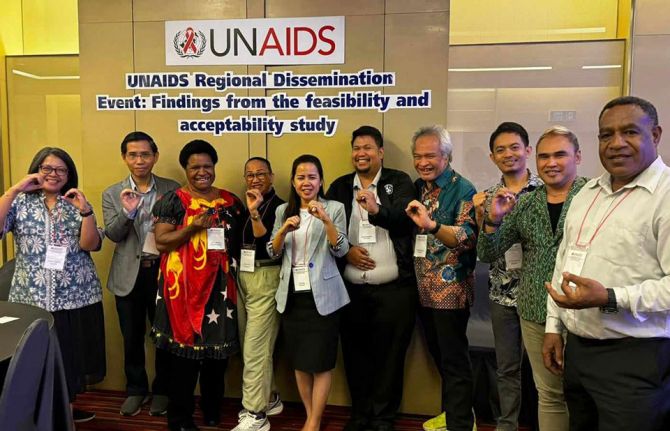
Feature Story
Advocating for HIV trials that work for women
11 December 2008
11 December 2008 11 December 2008
Women and girls, who constitute half of all people living with HIV, are often underrepresented in biomedical HIV trials, particularly those assessing new treatment drugs or strategies.
Credit:UNAIDS/P.Virot
Women and girls, who constitute half of all people living with HIV, are often underrepresented in biomedical HIV trials, particularly those assessing new treatment drugs or strategies. When they are included, it may be in numbers that do not allow conclusions to be drawn about them. In spite of biological differences between men and women that can influence drug metabolism, research data may not be disaggregated, analyzed, and reported by sex.
One year ago today, a two-day meeting concluded which marked the beginning of the Women and HIV Trials initiative. This new forum opened a dialogue among peer academics, scientists and policymakers to challenge research norms underpinning the relative invisibility of women in clinical trial design, implementation, and reporting. The event was hosted by four partners, UNAIDS, the Global Coalition on Women and AIDS (GCWA), the International Centre for Research on Women (ICRW), and Tibotec.
A year on, the Women and HIV Trials initiative is generating interest at a global level. “The greatest success of the last year has been the simultaneous, multi-pronged approach to the challenge of the participation of women in HIV trials,” says Karen Manson of Tibotec, co-organizer of the original gathering.
“The Geneva meeting has catalysed many actions and initiatives - some directly the result of working groups that were established at the meeting but many others that are the indirect result of individuals being motivated to push for progress wherever possible.”
A number of strategic areas were identified during the initial 2007 consultation and formulated into an action plan implemented under the themes of: trial design, trial conduct, and reporting of results.
Trials designed with women in mind
In order to get an accurate picture of the participation of women in clinical trials, one of the activities of the last year has been to evaluate progress since 2000 in the proportion of women involved in later phase HIV clinical trials. The “score card” exercise found that publicly funded trials, such as the National Institute of Health (NIH)-sponsored trials in the USA, involve a significantly higher proportion of women participants than privately sponsored trials. The NIH commitment to adequate representation of women in their clinical trials follows on legislation in the USA on the inclusion of women and minorities in government sponsored trials.
“The progress seen in the US as a result of the Public Law revitalization act is indeed good news. However, clearly we still have far to go to meet these standards for HIV treatment trials” said Dr Sharon Walmsley, Professor of Medicine at the University of Toronto, Canada, who presented the results of this exercise at the International AIDS conference in Mexico in August 2008.
Trial recruitment and retention
Persuading women to join clinical trials can be difficult. Where women do enrol in trials, research shows that, due to a range of circumstances, they may drop out early. There is recognition that the involvement of community groups, including women’s groups, in trial design and implementation discussions can improve enrolment and retention. Reaching out to the places where women may gather or making existing trial sites more women-friendly, with child care and flexible schedules for instance, are ways to attract and retain women trial participants.
Trials run with needs of women met
Trial organizers have ethical responsibilities to participants. Clinic trial conduct can affect the health of research subjects. In HIV clinical trials, there is a duty to provide specific health care services, such as HIV prevention measures and access to antiretroviral treatment when it is indicated. For women participants, the health care package offered should also include sexual and reproductive health services, including regular pap smears for cervical cancer and screening for sexually transmitted infections.
“In defining the sexual and reproductive health care package to be provided to women in HIV trials, trial sponsors have the opportunity to do good and do well,” says Anna Forbes, Deputy Director, Global Campaign for Microbicides.

The Women and HIV Trials Initiative aims to stimulate people to think freshly about research practices.
Credit:UNAIDS/P.Virot
Forbes, a member of the “Women and HIV trials” initiative, is working with others to draw up guidance on the elements of a standardized sexual and reproductive health package for HIV trials. She underscored the important of providing acceptable contraceptive, reproductive, and sexual health care services—offered on-site when possible—to boost participant recruitment and retention and improve trial power by minimizing the rate of unintended pregnancies.
“Using trial resources to build sustainable access to such care after the trial is over (for example by training local public health staff and purchasing equipment that can be left for the community’s on-going use) also helps meet trials’ ethical responsibilities to reduce global disparities in access to health care whenever possible through trial conduct itself” says Forbes.
Trials that take into account the wider context of gender
The Women and HIV trials initiative has led to discussions on the role of clinical trials in exploring social factors, such as gender, that may explain differences in responses to an intervention being investigated. The International Center for Research on Women (ICRW) is taking the lead in promoting a social science perspective in trials.
At 2008 International AIDS Conference held in Mexico this summer, at which for the first time a number of satellites were held on “Women and HIV Trials”, ICRW launched a publication on the challenges of recruiting and retaining women in clinical trials.
Geeta Rao Gupta, the head of ICRW and a Steering Group member for the Women and HIV Trials initiative argues: “Clinical trials offer an unparalleled opportunity to collect and report social and behavioural data that can provide a more complete picture of the gender context of the HIV epidemic.”
Trials that report on sex differences
There are a number of differences in the way men’s and women’s bodies work. For example, body mass, hormonal cycles, and rates of metabolism are different by sex. However, when outcomes of trials come out in peer journals, these published scientific articles often do not report trial results by sex. This means that we remain blind to differences in drug levels and dosages in men and women.
The Women and HIV Trials Initiative aims to stimulate people to think freshly about research practices.
“When we set out to raise awareness and interest among a broad array of partners including researchers, community groups, national research sponsors, pharmaceutical companies, international regulatory authorities, and medical journal editors, we discovered there was a real surprise element,” notes UNAIDS Chief Scientific Adviser Catherine Hankins, a driving force behind the initiative.
“Many people told us that they had never thought about this issue before and had no idea that so little is known about sex differences in responses to drugs, including HIV medicines.”
To challenge this and pressure researchers designing trials, sponsors funding trials, and authors writing up trial results, the Women and HIV trials initiative is proposing a list of questions for the consideration of medical journal editors and peer reviewers as they assess trial manuscripts. They include two basic questions:
- Is the study powered to draw conclusions about women? In simpler terms, are the numbers of women enrolled sufficient to allow for statistical analysis and the drawing of conclusions about possible sex differences?
-
Has the data been collected, disaggregated, analyzed, and reported by sex?
CONSORT (Consolidated Standards of Reporting Trials), whose guidelines are an essential reference for authors looking for guidance on how to write up their trial results for publication, has recently added a link on its website to the UNAIDS Women and HIV trials web page.
Next steps
Catherine Hankins reflects on the last year as a successful foundation for continued advocacy with a framework for action and the development of outreach materials - meeting report, brochure, score cards, website. “We have been creating momentum to change research norms so that women are better represented in HIV clinical trials and so that reporting of sex-specific results becomes routine,” she says. One of the important next steps for the Women and HIV Trials initiative, according to steering committee member Karen Manson, will be to demonstrate tangible results:
“Showing that more women are participating or having access to HIV clinical trials will be critical in breaking down the perception that it is an insurmountable challenge.”
Hankins sees a collaborative approach as the key to the consolidation and long-term success of this initiative:
“Our next step is to continue building a network of partners to advocate for placing women and adolescent girls at the centre of HIV clinical research.”
Through this, an impact on the wider epidemic is possible. As Director of the Global Coalition on Women and AIDS Kristan Schoultz states: “If our response to AIDS isn’t working for women - and that includes our response from the clinical trials perspective - it’s basically not going to work at all.”
Advocating for HIV trials that work for women
Partners:
Global Coalition on Women and AIDS
International Centre for Research on Women
Tibotec
Feature stories:
Meeting ethical concerns over HIV trials (3 December 2007)
The role of women in HIV trials (5 December 2007)
Experts meet on women and HIV clinic trials (7 December 2007)
External links:
Science magazine Special Online Collection: Clinical Trials and Tribulations (October 2008)
Speeches:
Contact:
For more information please email womenandtrials@unaids.org
Publications:
Clinical Science Meets Social Science: Gender and AIDS Vaccine Research (ICRW, IAVI) (pdf, 2.70 Mb)
Making HIV trials work for women and adolescent girls (July 2008) (pdf,140 kb )
Gender and Sex-Based Analysis in Health Research: A Guide for CIHR Researchers and Reviewers (Canadian Institutes of Health Research)
Ethical considerations in biomedical HIV prevention trials (pdf, 750kb)
Good participatory practice guidelines for biomedical HIV prevention trials (pdf, 3.04Mb)
Presentations at satellite session XVII International AIDS Conference, Mexico City, August 2008:
Women and Trials in High-Income Settings: Clinical Investigator Perspective
Judith S. Currier (ppt)
What does sexual & reproductive health have to do with clinical trials?
Anna Forbes (ppt)
Women and Trials in Low and Middle-income settings: the clinical investigator’s
Perspective Beatriz Grinsztejn (ppt)
Women and clinical trials: where have we been and where are we going?
Catherine Hankins, Chief Scientific Adviser to UNAIDS (ppt)
Women’s Participation in Clinical Trials - Are we POWERED to meet the Challenge?
Dr Sharon Walmsley (ppt)
Creating Meaningful Research for Women: Issues and challenges from the community perspective
Heidi Nass (pdf)



